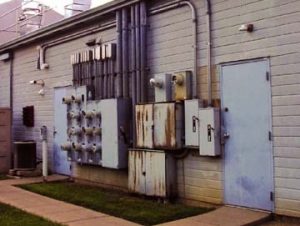Electric Signs
Completing the Circuit
Readers help make a stronger connection to the National Electrical Code.
Published
18 years agoon

My September column provided some general, installation guidelines regarding branch circuits for electric signs (see September ’04, page 64, and the charts showing the maximum load capacity for various circuits). Recognizing that registered electricians aren’t always the people who install and connect signs, I focused on basic precautions involved in performing this work.
I didn’t intend to discuss the National Electrical Code (NEC) in this column, but a few readers were concerned that some of my statements and terminology didn’t conform to the official code book. To clarify any misunderstandings, therefore, let’s revisit some of these points with the expert assistance of Larry T. Cox, a registered Master Electrician and owner of Cox Electric (Seffner, FL).
Circuit ratings
The NEC dictates ratings for electric-sign branch circuits. NEC Article 600.5 (A) Branch Circuits states, "Each commercial building and tenant shall have a dedicated sign circuit, and the minimum branch circuit rating shall be 20 amperes." But the NEC provides more precise guidance based on the type of sign. Article 600.5 (B) Rating states that fluorescent or incandescent signs are restricted to 20-amp circuits. But Article 600.5(B)(2) specifies that 30-amp circuits may be used to operate neon signs.
As a sign contractor, however, I encountered several existing, fluorescent signs that were connected to either 15- or 30-amp circuits, which violates NEC rules. However, the code permits connecting more than one sign to each circuit. Cox explained, "Article 600.5 doesn’t limit the number of signs on a particular circuit, as long as the total load doesn’t exceed 16 amps.
For example, four fluorescent or incandescent signs, each drawing a 4-amp load, may be connected to a single, 20-amp circuit." Definitions Sign installers commonly refer to the three conductors feeding a sign as "hot," "ground" and "green" wires. But these imprecise terms don’t conform to NEC definitions. Identifying primary conductors by color is undesirable, because the actual wiring connections may not agree with the color code.
AdvertisementThe ungrounded conductor, commonly known as the "hot," typically is black, red or blue. What truly defines this conductor, however, is that it connects directly to the load side of a circuit breaker or fuse, with no connection to ground. The grounded conductor, commonly known as the "ground," connects to a grounded lug bar in the electrical panel.
According to Article 200.6 (A), this conductor should be white, gray or white-striped, in any color besides green. Sign installers sometimes refer to this conductor as the "neutral," but this term is incorrect in electrical terminology. "You only find a neutral wire in two places," Cox said. "First, the grounded conductor at the service is the neutral. The other place is in a multiwire branch circuit." (Refer to Article 100 Definitions).
The grounding conductor, referred to in my September column as "the green wire," connects the metal body of a sign — or the grounded circuit of a wiring system — to a grounding electrode or electrodes. "This wire is strictly for handling fault current, and it shouldn’t be used to carry a load under normal conditions," Cox said. It’s not uncommon, however, to encounter an electric sign that has been "repaired" by disconnecting a broken grounded conductor (white wire) and replacing it with the grounding conductor (green wire).
This is a dangerous practice for two reasons. First, it utilizes a wire that’s not intended to carry continuous current. Second, it converts an approved, three-wire system to a potentially hazardous, two-wire system. Several years ago, a major, national sign program ordered corrective work on thousands of existing signs because installers had failed to properly ground the metal sign structures.
Such faulty practices are costly — and deadly. In Florida, a child was electrocuted when he contacted a metal portion of an ungrounded, freestanding sign. Electrocution can occur if an ungrounded conductor is broken and in contact with a metal portion of the sign. Without a grounding conductor to provide a fault pathway, a person standing at the sign’s base may provide the path of least resistance to ground.
Calculating required wire size
AdvertisementAn online calculator, found at www.electrician.com, enables installers to determine the correct wire size for a particular installation. Users simply input the system’s voltage and phase; the sign’s total operating load in amps; the distance from the sign to the power source; and the expected ambient temperature to which the wiring system is exposed.
My September column provided wire-size calculations based on the 3% maximum allowable voltage drop for any branch circuit (from the panel to the point at which the sign is connected). But in certain cases, the 3% rule may not apply. Cox reminds installers to "start at the real power source — the electrical service." A building’s electrical service is located at the electric meter.
Although the service is often located proximate to the panel, some panels are located hundreds of feet away from the services. Cox explained, "To accurately calculate voltage drop, one must consider the difference between the voltage reading at the service and the point at which the sign is connected. The voltage drop from the service to the sign can’t exceed 5%.
Therefore, if a 3% voltage drop already exists across feeder wires from the service to the panel, the sign circuit’s allowable voltage drop is restricted to only 2%." Thus, a sign installer must know the feeder circuit’s voltage drop to determine a sign circuit’s correct wire size.
If the service is located close to the panel, the feeder’s voltage drop may be negligible, and the 3% rule for branch circuits may hold. But more remote panels reduce the branch circuit’s maximum allowable voltage drop. Of course, to take accurate voltage readings, signs must be turned on and fully illuminated.
Odds and ends
AdvertisementMy September column also stressed the importance of grounding conduits. Cox amplified this important issue: "Most, if not all, sign installers carry flexible, metal conduit rather than electrical metallic conduit (EMT) or rigid conduit. Flexible conduit is easier to use when installing building-mounted signs." Cox reminds installers that, according to Article 250.118 (1-14), flexible conduit must be listed for grounding.
Caution is also necessary when a sign requires more than a single, 20-amp circuit. Ordinarily, this requires the installation of two or three, adjacent circuit breakers, stacked vertically on the same side of the panel. The switches connect via a throw bar, which makes the breakers operate simultaneously.
"But if a panel has a four-wire feeder and is 120/240 Delta with a high leg," Cox said, "every third breaker in the panel will be 208V to the grounded conductor. Therefore, if two breakers are placed side by side in this type of panel, and one breaker lands on the high leg, excessive voltage will damage any electric sign connected to the circuit."
Circuit-breaker switches should function principally as overcurrent-protection devices — they’re not intended for continuous use as on/off switches. However, many people use circuit breakers for daily switching. Cox said, "Continued use of a standard breaker can result in a loose connection or perhaps a fire inside the panel." At the very least, the constant use of a circuit breaker for switching will substantially reduce its lifetime.
Nuts and volts
When planning branch-circuit installations for new or existing signs, always follow the NEC’s guidance. Non-electricians who are frequently involved in sign-circuit installations should seek qualified electricians’ advice so their work conforms to electrical regulations.
Sign-industry veterans often describe themselves as "jacks of all trades." The sign industry involves multiple specialties, including design, fabrication, erection, electrical installation, service, neon fabrication, concrete work, welding and painting. Few sign professionals possess the time or resources to master all of these trades. But ST‘s well-qualified readers — in each of these specialties — provide the magazine with valuable input, which is always welcome.

SPONSORED VIDEO
Introducing the Sign Industry Podcast
The Sign Industry Podcast is a platform for every sign person out there — from the old-timers who bent neon and hand-lettered boats to those venturing into new technologies — we want to get their stories out for everyone to hear. Come join us and listen to stories, learn tricks or techniques, and get insights of what’s to come. We are the world’s second oldest profession. The folks who started the world’s oldest profession needed a sign.
You may like

PRINTING United Alliance Forms Strategic Partnership with ASI

The Joy of Working

5 Signs That Embody Care and Gratitude
Subscribe

Bulletins
Get the most important news and business ideas from Signs of the Times magazine's news bulletin.
Most Popular
-

 Photo Gallery1 week ago
Photo Gallery1 week ago30 Snapshots of the 2024 ISA Sign Expo
-

 Ask Signs of the Times1 week ago
Ask Signs of the Times1 week agoWhy Are Signs from Canva so Overloaded and Similar?
-

 Paula Fargo6 days ago
Paula Fargo6 days ago5 Reasons to Sell a Sign Company Plus 6 Options
-

 Real Deal3 days ago
Real Deal3 days agoA Woman Sign Company Owner Confronts a Sexist Wholesaler
-

 Benchmarks2 weeks ago
Benchmarks2 weeks ago6 Sports Venue Signs Deserving a Standing Ovation
-

 Photo Gallery6 days ago
Photo Gallery6 days ago21 Larry Albright Plasma Globes, Crackle Tubes and More
-

 Women in Signs1 week ago
Women in Signs1 week ago2024 Women in Signs: Brandi Pulliam Blanton
-

 Women in Signs1 week ago
Women in Signs1 week ago2024 Women in Signs: Alicia Brothers













